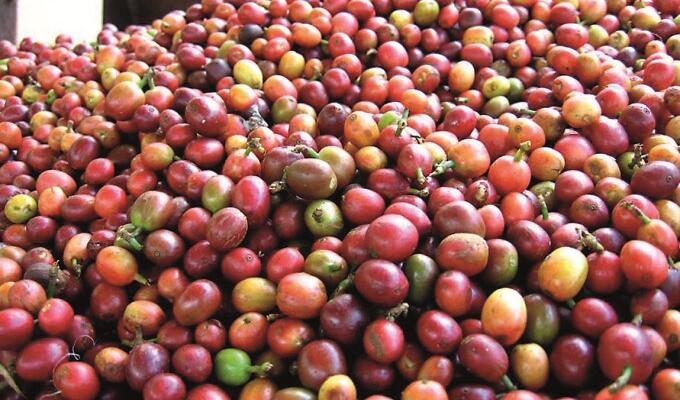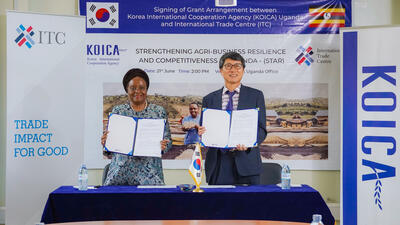

Coffee Guide marks 20 years of service (en)
Well-thumbed by newcomers and experienced trades people alike, The Coffee Exporter’s Guide has become a standard industry reference. In addition to providing authoritative information on subjects such as logistics, risk management and quality control, the new edition includes sections on climate change, the role of women in the coffee sector and comparisons of sustainability schemes.
“When I started as an independent coffee trader, I had no idea about the trading, milling or export process of this commodity. Through The Coffee Exporter’s Guide, I began to know the world of coffee.” - Faye Campos W.,
Chief Executive Officer of FC Trading, Costa Rica
“This book sits on our trading desk,” said Chino Lizano, who works with the companies Nature’s Best Coffee and Deli Café in San José, Costa Rica. “We refer to it as our bible, which we check when any question or doubt arises in our business. This is a useful and handy tool that everyone in the coffee trade should have.”
“The Coffee Exporter’s Guide is undoubtedly one of the most consulted publications in our library’s extensive collection,” said Martin Wattam, who manages the library of the International Coffee Organization in London. “It provides a comprehensive yet concise source of practical information to the International Coffee Organization’s diverse network of stakeholders across the global coffee sector.”
Extending development impact
In developing countries, the book is being used as a tool to improve coffee quality and visibility in international markets. In October 2011, as part of the NTF II programme, Uganda’s National Union of Coffee Agribusinesses and Farm Enterprises (NUCAFE) used The Coffee Exporter’s Guide in an ITC training session for farmer associations. Just two months later, participants were already improving the ways they store, dry and sort coffee.
Five of these farmer associations went on to win top prizes at the Taste of Harvest National Cupping Competition in January 2012, where an international expert panel judged the taste and quality of 35 Uganda Arabica coffees. The Ugandan winners, with the support from the NTF II programme, proceeded to the annual African Fine Coffee Conference, where international buyers and traders “cupped” the best coffees from each country, in a regional competition.
In the Central American chapters of the International Women’s Coffee Alliance (IWCA), women in the coffee industry are benefiting from the guide as they team up with NGOs to reach international markets. Project2Love is an American foundation, based in California, which sources coffees from women producers in Central America. Founders Mery Santos, owner of the El Dorado Roasting Company, and Renee Planje use The Coffee Exporter’s Guide and the Guide to Geographical Indications, also published by ITC, as “valuable tools to make people familiar with the industry.”
In Zambia, the book is shared with farmers through its national coffee association. “Upon reading the guide, I immediately arranged to have copies for each of our large-scale farmers, who constitute the largest percentage of our productive membership,” said Joseph Taguma, General Manager of the Zambia Coffee Growers’ Association. “As someone involved in teaching farmers and staff on coffee quality and trading matters, I still find that The Coffee Exporter’s Guide is a valuable source for teaching materials. It is easy to follow and deals with the real issues of coffee quality and trading.”
“When I started as an independent coffee trader, I had no idea about the trading, milling or export process of this commodity,” said Faye Campos W., Chief Executive Officer of FC Trading, based in Alajuela, Costa Rica. “Through The Coffee Exporter’s Guide, I began to know the world of coffee. It took me through the entire process — production, process, quality control and especially everything related to marketing: negotiation, price fixing, shipping conditions and documents, insurance and all the necessary information to sell and export coffee. This book was the basis for developing my current experience.”
An online, living network
The companion website, www.thecoffeeguide.org, is a knowledge-sharing tool which uses the content of The Coffee Exporter’s Guide as a basis to serve producers, exporters and those who support them in coffee-producing countries worldwide. The site comes alive thanks to a network of highly experienced volunteers who answer visitors’ questions on the website’s discussion board. The discussions have influenced the content of the latest edition of the guide.
“A unique feature of The Coffee Exporter’s Guide — and this came in the picture some time after the first publication — has been the online question-and-answer section,” said Taguma. “It has provided a platform for cases which one may not have
thought much about. This has really been very helpful. I have used this service and gotten answers to my own questions.”
The book’s greatest strength may be in the numbers. More than 100 industry experts, companies and institutions, in partnership with ITC, have worked to make the guide relevant, neutral and hands-on. Industry associations have played an important role in making sure the book is well used. “Along with other directors, I ensured that The Coffee Exporter’s Guide was part and parcel of each annual conference and exhibition,” said Taguma, who is also the former chairman of the Eastern African Fine Coffees Association. “The guide was a high point of our last conference. As more farmers seeking to produce quality coffee still need to be reached, I hope the guide will be made available to them through such conferences for many years to come.”















